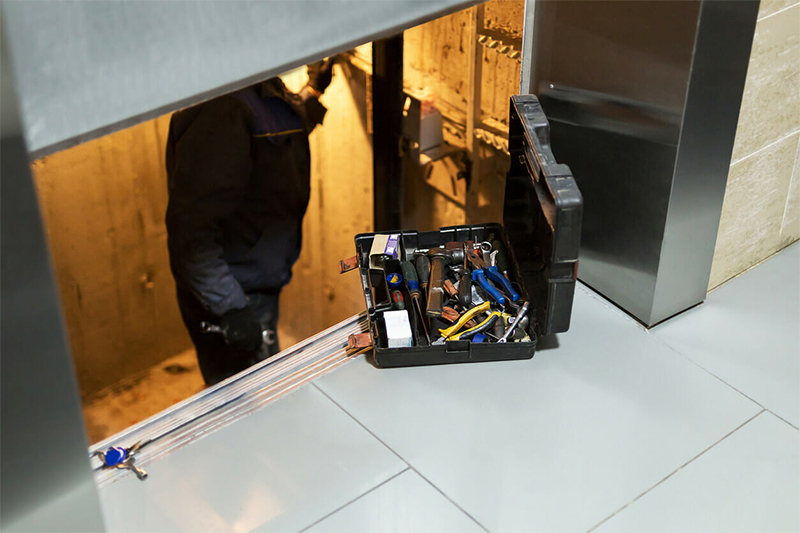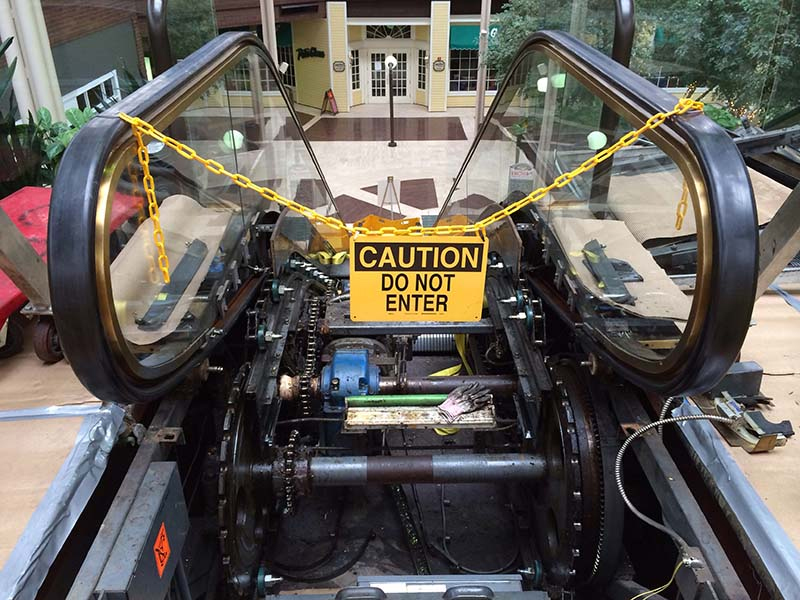Escalators and elevators are commonly found in buildings and public spaces. Escalators are moving staircases that transport people between different building levels, typically moving in a continuous loop. They are a convenient and efficient way to move many people up and down without physical exertion.
Elevators are often equipped with doors, controls, and safety features to ensure passengers’ smooth and safe transportation between floors. Both escalators and elevators provide accessibility and convenience, especially for individuals with mobility challenges or carrying heavy belongings.
Types of Elevator Malfunctions
From mechanical malfunctions to safety concerns, elevator issues can cause major disruptions and inconvenience. Recently, in 2023, an elevator malfunction injured three workers at one of Manhattan’s newest office buildings. [1]
- Door Issues: Elevator doors failing to open or close properly is a frequent problem. This can be caused by issues with the door sensors, misalignment, or mechanical failures.
- Stuck Between Floors: Elevators getting stuck between floors is a terrifying experience for passengers. It can occur due to mechanical failures, power outages, or issues with the elevator’s control system.
- Overcrowding: Elevator overcrowding can lead to malfunctions and safety risks. Exceeding the elevator’s weight limit can cause it to malfunction or get stuck.
- Sudden Stops: Elevators may experience sudden stops, jolts, or jerks during operation. This can be caused by various factors such as mechanical problems, electrical issues, or programming errors.
- Faulty Controls: Malfunctions in the elevator control system can lead to erratic behavior, including stopping at the wrong floors, skipping floors, or opening doors unexpectedly.
- Power Failures: Power outages or fluctuations can disrupt elevator operation, causing them to stop working altogether or become temporarily stranded between floors.
- Emergency Brake Activation: Elevators have emergency brakes designed to engage in the event of a malfunction or power failure. However, false activations or malfunctions of the emergency brake system can cause unnecessary delays and inconvenience.
- Mechanical Failures: Elevator components such as cables, pulleys, motors, and brakes can experience mechanical failures due to wear and tear, lack of maintenance, or manufacturing defects.
- Sensor Malfunctions: Elevator sensors play a key role in detecting obstructions, ensuring proper door operation, and preventing accidents. Malfunctioning sensors can lead to door-related issues, delays, or unsafe conditions.
- Communication Failures: Elevator emergency communication systems, such as intercoms or alarm buttons, may fail to function properly during emergencies, compromising passenger safety and security.

Common Escalator Malfunctions
Escalators are a convenient mode of vertical transportation in many public spaces, such as shopping malls, airports, and train stations. While they are designed to transport people from one floor to another safely, escalator issues can sometimes arise, posing potential risks to users.
From maintenance issues to safety concerns, it is important to be aware of common problems with escalators to ensure the safety of those who rely on them for daily transportation.
Here are some common escalator issues that could lead to personal injury.
- Stairs Misalignment and Trips: Misaligned steps can create gaps or uneven surfaces, increasing the risk of trips and falls. The potential injuries from such incidents range from sprained ankles to fractures or even head injuries resulting from falls.
- Entrapment in Moving Parts: Clothing, shoelaces, or accessories can get caught in escalator components, leading to bruises, lacerations, or more severe injuries if clothing becomes entrapped.
- Sudden Stops and Starts: Mechanical malfunctions can lead to abrupt stops or unexpected starts, causing passengers to lose balance and resulting in falls and injuries.
- Handrail Malfunctions: Issues with the handrail, such as sudden stops or malfunctions, can catch passengers off guard, potentially leading to falls or injuries when passengers rely on the handrail for stability.
- Inadequate Maintenance: Regular maintenance is crucial for escalator safety, and lack of proper upkeep can lead to various issues, such as mechanical failures, component malfunctions, or escalator shutdowns, resulting in potential injuries.
- Poorly Lit Areas: Insufficient lighting on escalators or surrounding areas can contribute to accidents, leading to trips, falls, or injuries caused by inadequate visibility. Adequate lighting is essential for passenger safety.
- Escalator Design Flaws: Flaws in the design, such as excessively steep angles or inadequate safety features, can pose risks, resulting in various injuries depending on the nature of the design flaw.

Personal Injury Claims for Escalator and Elevator Accidents
Escalator and elevator accidents can result in severe injuries and substantial medical expenses. When a person is injured due to an escalator or elevator malfunction, they may have a valid personal injury claim. This type of claim can help the victim recover damages for medical bills, lost wages, pain and suffering, and other related expenses.
To pursue a personal injury claim for an escalator or elevator accident, it is important to understand the legal process and the steps involved in filing a claim.
- Liability: Determine who is responsible for maintaining and ensuring the escalator’s or elevator’s safety.
- Evidence: Gather essential evidence such as photographs, witness statements, and maintenance records.
- Injuries: Document and obtain medical records to assess the full extent of injuries.
- Time Limits: Be aware of the time limits for filing a claim for personal injury.
- Legal Representation: Consult our personal injury attorney with experience in handling such claims.
- Compensation: Seek fair compensation for medical expenses, lost wages, and other damages.
- Maintenance and Safety Regulations: Understand the relevant regulations and regulatory compliance, as they may be factors in determining negligence.
Types of Injuries Commonly Experienced in These Accidents
In escalator and elevator accidents, individuals may commonly experience a range of injuries, including:
- Amputations
- Broken bones or fractures
- Crush injuries
- Internal injuries or organ damage
- Lacerations and bruises
- Post-traumatic stress disorder (PTSD) or emotional distress
- Soft tissue injuries such as sprains and strains
- Spinal cord injuries
- Trauma to the head, neck, or back
- Traumatic brain injuries (TBI) or concussions
The severity of the injuries can vary based on the nature of the accident and may require immediate medical attention and ongoing treatment. Individuals involved in these accidents must seek medical evaluation to assess and treat injuries sustained.

Have You Been Injured in an Escalator or Elevator Accident?
Contact Goldberg & Loren to schedule a free consultation and pursue your rightful compensation.
FAQs
Source:
[1] 3 workers hurt after elevator malfunctions, drops several stories inside Manhattan building. (2023, March 22). ABC7 New York. https://abc7ny.com/one-vanderbilt-elevator-malfunction-workers-injured-nyc/12988330/

